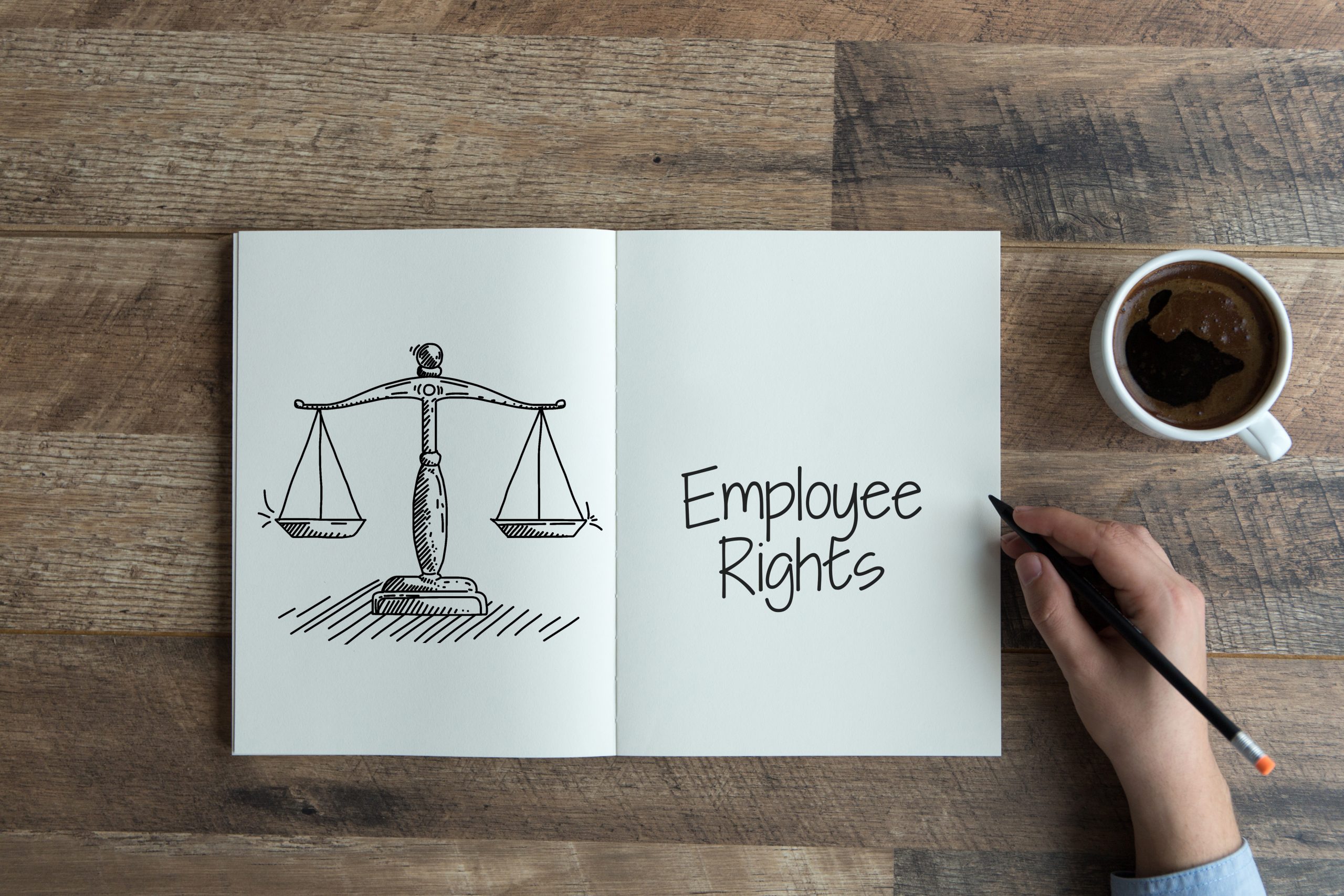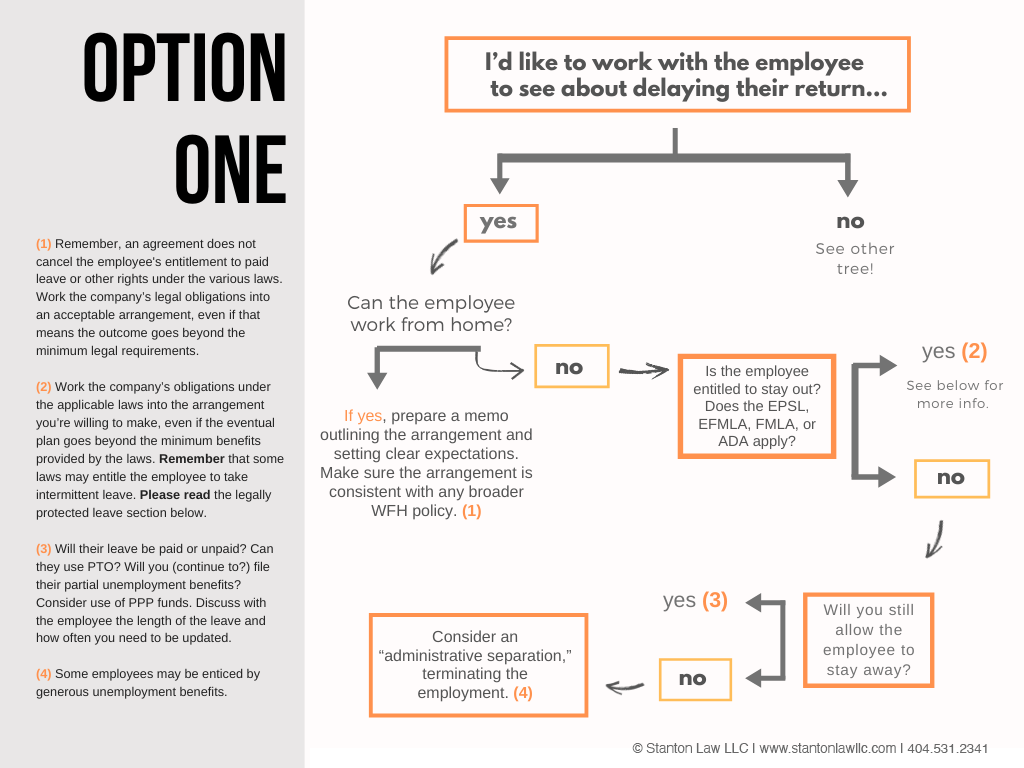
So you’re ready to reopen your business, eh? You’ve cleaned the office, installed new hand-wash and sanitizer stations, and ordered a pallet of disinfectant wipes. You’re prepared to screen employees, you’ve adjusted schedules to allow spacing, and you are all set to encourage social distancing. You’re pleased that most of your employees have heeded the call to come back in. But what about the employee who bristles at the idea of returning to work and, with one degree of diplomacy or another, tells you he is not quite ready?
Broadly speaking, you’re then faced with another choice: Will you take a more casual, appeasing approach and explore with the employee the options that may allow him to delay his return? Or will you be a bit firmer and insist that he get back to work unless he has a legally entitled right to remain out? Different situations may lead to different answers, but whichever path you choose will lead to dozens of possible decisions. We’ve outlined the following think-trees that could help you navigate several common contingencies and the questions you need to think through. With the more specific direction of a qualified employment lawyer, we hope you’ll quickly arrive at the decision that’s best for your company and the employee.
As a threshold matter, a company should assure its employees that it is complying with the applicable and relevant laws, which in this case are most likely to include the Families First Coronavirus Response Act (FFCRA), which itself incorporates the Emergency Paid Sick Leave (EPSL) and Emergency Family and Medical Leave (EFML) Acts. Other relevant laws include the “Classic” Family and Medical Leave Act (FMLA), the Americans with Disabilities Act (ADA), and similar state laws and local mandates concerning COVID-19 and employee leave. In addition to mandatory posters and other notifications, your communications should advise employees (even if with broad strokes) that they may have rights under the laws and invite them to share with you their questions in this regard.
The employer should also clearly explain the measures the company has undertaken (and will undertake) to help ensure a safe workplace. If appropriate, employers can note that the owners and supervisors are returning to and working in the same environment, so they have every interest in making sure folks are safe. Also, consider inviting employees with particular concerns to suggest improvements to and additional steps beyond what the company has already considered.


Legally Protected Leave
Recognize that, with just a little additional information from the employee, some non-protected reasons for remaining on leave may become protected reasons. For instance, an employee’s age alone does not entitle him or her to an accommodation, but the employee’s age and history of medical problems may entitle the employee to one type of protection or another. Likewise, even though an employee’s general or unspecified fear of contracting CV19 is not sufficient to confer an entitlement, an employee who suffers from clinical anxiety may qualify for an ADA accommodation. Simply living with someone who may be more at risk for CV19 is insufficient, but serving as a caregiver for someone in his or her household who is under a quarantine/isolation order likely entitles an employee to protection.
• Employee Paid Sick Leave Act: In companies with fewer than 500 employees, an employee who is under quarantine/isolation orders, is symptomatic and seeking a medical diagnosis, is giving care to someone under a quarantine, or whose minor child’s usual caregiver is unavailable may be entitled to up to two weeks of paid leave; the leave may, depending on the reason for the leave, be taken intermittently.
• Emergency Family & Medical Leave Act: In companies with fewer than 500 employees, an employee who has been with company more than 30 days, and whose minor child’s usual caregiver is unavailable, may be entitled to up to ten weeks of paid leave; the leave may, depending on the circumstances, be taken intermittently.
• “Classic” Family & Medical Leave Act: If your company is covered by the FMLA, the employee is subject to FMLA, and if the employee has a qualifying “Serious Health Condition” preventing them from working, he or she is likely entitled to up to 12 weeks of unpaid leave (that may be available intermittently).
• Americans with Disabilities Act: Companies with 15 or more employees have to provide reasonable accommodations for qualified individuals with disabilities. Lots of jibber-jabber in there, but in the CV19 context, this means that you may have to make accommodations for someone who, for instance, has asthma or a heart condition or severe anxiety. That may be an unpaid leave, a work-from-home plan, or other mechanism to let them perform their job (now or later).
Stanton Law Attorneys Are Here to Help
We will continue to monitor COVID-19-related return-to-work requirements as they develop and provide updates regarding their impact on your business. If you have questions about making the decision that’s best for your company and employees, don’t hesitate to contact us. We can help you understand your risk and responsibilities as the situation evolves. If you need a business law expert, the experienced Atlanta business attorneys at Stanton Law are available by phone at 404-881-1288 or online.